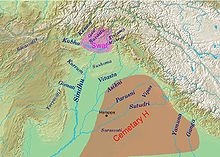The Rigveda refers to a number of rivers located in the northwestern Indian subcontinent, from Gandhara to Kurukshetra.

Rigvedic geography
Identification of Rigvedic hydronyms has engaged multiple historians; it is the single most important way of establishing the geography and chronology of the early Vedic period.[1][2] Rivers with certain identifications stretch from eastern Afghanistan to the western Gangetic plain, clustering in the Punjab. The Rigveda mentions the sapta-sindhavaḥ (Sanskrit: सप्तसिन्धवः, seven rivers), along with other rivers:
“He has surveyed eight summits of the Earth, three shore or desert regions, seven rivers.” (aṣṭaú vy àkhyat kakúbhaḥ pr̥thivyā́s trī́ dhánva yójanā saptá síndhūn RV.I.35.8).[3]
Sapta-sindhavaḥ is cognate with Avestan hapta həndu, and is interpreted as referring to Punjab.[a] The region's name comes from پنج, panj, 'five' and آب, āb, 'water' thus "five waters", a Persian calque of the Indo-Aryan Pancha-nada meaning "five rivers".[4]
The same names were often imposed on different rivers as the Vedic culture migrated eastward from around Afghanistan (where they stayed for a considerable time) to the subcontinent via Punjab.[1]
List of rivers
Multiple hydronyms are located in the Rigvedic corpus; they are slotted according to rough geographical locations, following the scheme of Michael Witzel.[1] Alongside, opinions of scholars about modern correlates are provided:[5][6]
Indus:
Northwestern Rivers:
- Tr̥ṣṭā́mā – Blažek identifies with Gilgit.[5] Witzel notes it to be unidentified.[1]
- Susártu – Unidentified.
- Ánitabhā – Unidentified.
- Rasā́ – Described once to be on the upper Indus; at other times a mythical entity.[5]
- Mehatnū – A tributary of Gomatī́.[5] Unidentifiable.[1]
- Śvetyā́ – Unidentified.
- Kúbhā – Identified with Kabul river.
- Krúmu – Identified with Kurrum.
- Suvā́stu – Identified with Swat.
- Gomatī́ – Identified with Gomal.
- Saráyu / Harōiiu – Blažek identifies with Sarju.[5] Witzel identifies with Hari.[1]
- Kuṣávā – Probably the Kunar River.
- Yavyā́vatī – Noted to be a branch of Gomatī́. Witzel as well as Blažek identifies with Zhob River.[1][5] Dähnhardt comments it to be synonymous to Yamúnā or flowing very close to it.[6]
Eastern tributaries:
- Suṣómā – Identified with Soan.
- Arjikiya – Blažek identifies with Haro.[5] Witzel speculates it to be Poonch or Tawi.[1]
- Rivers of Punjab:
Eastern Rivers:
- Áśmanvatī – Identified with Assan.
- Yamúnā – Identified with Yamuna.
- Aṃśumátī – Probably an epithet for Yamúnā.[5]
- Gáṅgā – Identified with Ganga.
See also
- Ap (water)
- Aryan migration
- Nadistuti sukta
- Old European hydronymy
- Out of India theory
- Rigvedic deities
- River goddess
- Samudra
- Zhetysu – 7 rivers of Central Asia
References
- ^ 'Seven Rivers' include Indus and the five rivers of Punjab. Seventh is generally believed to be the legendary Sarasvati; however, J. S. Grewal considers river Kabul more likely to be the seventh river instead.[4] See also Avestan geography#Vendidad references
- ^ a b c d e f g h Witzel, Michael (1998). "Aryan and non-Aryan Names in Vedic India: Data for the linguistic situation, c. 1900-500 B.C". In Bronkhorst, James; Deshpande, Madhav (eds.). Aryans and Non-Non-Aryans: Evidence, Interpretation and Ideology. Harvard Oriental Series. Cambridge. pp. 337–404.
{{cite book}}: CS1 maint: location missing publisher (link) - ^ "Sapta Sinhavas- The land of seven rivers" (PDF). M. Aslamkhan.
- ^ Wilson, H.H (27 August 2021). "Rig Veda 1.35.8 [English translation]". www.wisdomlib.org. Retrieved 22 May 2022.
- ^ a b Grewal, J. S. (2004). "Historical Geography of the Punjab" (PDF). Journal of Punjab Studies. 11 (1). University of California, Santa Barbara: 1–18. ISSN 0971-5223. OCLC 436148809.
- ^ a b c d e f g h i j k l Blažek, Václav (2016). "Hydronymia R̥gvedica". Linguistica Brunensia. 64 (2). Masaryk University: 7–54.
- ^ a b c d Dähnhardt, Thomas Wolfgang Peter (2009). "The descent of King Lion: Some considerations on the relations between the Indus and other rivers in the sacred geography and culture of ancient India". In Filippi, Gian Giuseppe (ed.). I fiumi sacri. Indoasiatica. Vol. 6. Libreria Editrice Cafoscarina. pp. 189–208. ISBN 9788875432416.
- ^ Kochhar, Rajesh (1999), "On the identity and chronology of the Ṛgvedic river Sarasvatī", in Roger Blench; Matthew Spriggs (eds.), Archaeology and Language III; Artefacts, languages and texts, Routledge, p. 262, ISBN 0-415-10054-2
- ^ Kar, Amal; Ghose, Bimal (1984). "The Drishadvati River System of India: An Assessment and New Findings". The Geographical Journal. 150 (2): 221–229. doi:10.2307/635000. ISSN 0016-7398. JSTOR 635000.
Further reading
- General
- Blažek, Václav. "Hydronymia R̥gvedica". In: Linguistica Brunensia. 2016, vol. 64, iss. 2, pp. 7–54. ISSN 2336-4440; ISSN 1803-7410.
- Gherardo Gnoli, De Zoroastre à Mani. Quatre leçons au Collège de France (Travaux de l’Institut d’Études Iraniennes de l’Université de la Sorbonne Nouvelle 11), Paris (1985)


Recent Comments